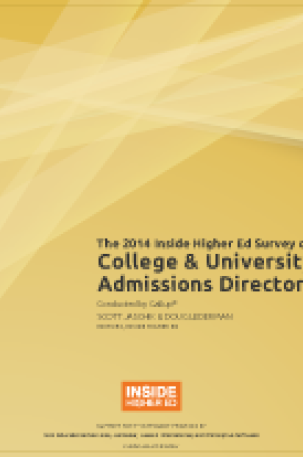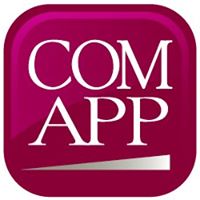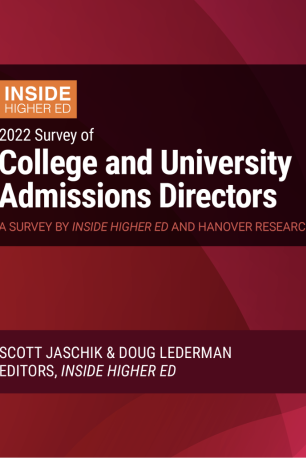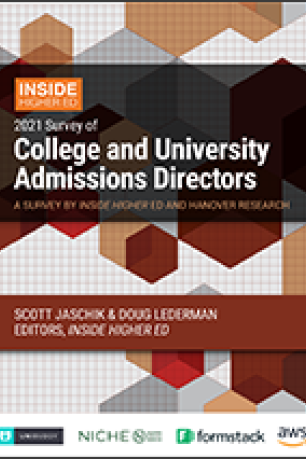Free Download

Last year was a difficult one for college admissions -- with institutions reporting more and more difficulty filling their classes.
Things aren't any better and they may be a little worse, according to the 2014 Inside Higher Ed Survey of College and University Admissions Directors. Slightly fewer colleges reported meeting their enrollment targets by May 1, more reported anxiety about meeting their targets, and more reported recruiting those who had already committed to other institutions. While the increases in all three areas were small, last year's totals were large -- and worrisome to many college leaders.
Other survey highlights:
- Very few admissions directors believe that President Obama's proposed ratings system will help college applicants and their families better understand the institutions they are considering.
- International students remain central to the enrollment goals of many institutions, with many institutions considering the use of agents or "pathways" programs to up their numbers.
- Despite all the publicity about the growing part-time student market, full-time students remain the focus of recruiting efforts at most institutions.
- The planned changes in the SAT are being widely applauded and may be key to the College Board, given that nearly half of admissions directors say they aren't paying any attention to the writing exam (part of the overhaul) and about 40 percent favor going test-optional.
- The technology problems with the Common Application caused problems at more than 8 in 10 institutions using the service, and while few colleges are planning to abandon the popular admissions system, a clear majority are distressed by its pricing policies, which some blame for leaving colleges in the lurch last year.
The survey was conducted by Gallup based on questions developed by Inside Higher Ed. Responses were received from 406 admissions directors. The survey specified that answers should come from the senior admissions official, but that title varies from campus to campus. All respondents were given complete anonymity, but information about their colleges' sectors was collected, allowing for analysis in some cases of differences in the attitudes of public and private, two-year and four-year institutions. A few questions were asked only of community college admissions directors.
About the Survey
Inside Higher Ed's 2014 Survey of College and University Admissions Officers was conducted in conjunction with researchers from Gallup. Inside Higher Ed regularly surveys key higher ed professionals on a range of topics.
On Oct. 8 at 2 p.m. Eastern, Inside Higher Ed will present a free webinar to discuss the results of the survey. Sign up here.
The Inside Higher Ed survey of admissions directors was made possible in part by advertising from ELS Educational Services, Liaison International, Jenzabar and Perceptive Software.
The results are being released today, as admissions leaders and high school counselors gather in Indianapolis for the annual meeting of the National Association for College Admission Counseling. (The full survey may be downloaded here.)
The Pressure Is On
Much of the public discussion of college admissions focuses on the difficulty of winning admission to the most elite private colleges and flagship universities. But the survey results show that, for most colleges and universities, the key issue is attracting enough suitable applicants (and those who will accept admissions officers), not sifting through hundreds of qualified applicants per spot.
Last year, just under 60 percent of admissions directors said they had not filled their fall class by the traditional May 1 deadline. This year, that total was up to 61 percent. Particularly striking was the shrinkage of private baccalaureate institutions that met their goal by May 1. Last year, 59 percent of them reported not meeting their targets. This year, that was up to 71 percent.
Thirty-two percent of college admissions directors (up from 29 percent last year) said that they recruited applicants after May 1 who had already committed to attending other institutions. (The Statement of Principles of Good Practice of the National Association for College Admissions Counseling bans such efforts.)
Another sign of the increased pressure: Asked how concerned they were about meeting this year's enrollment goals, 47 percent of admissions leaders said they were very concerned (up from 46 percent last year) and another 32 percent reported that they were moderately concerned (up from 30 percent). Only 5 percent of admissions directors were not concerned at all. Among those at private bachelor's institutions, 57 percent were very concerned and only 1 percent were not concerned at all.
Admissions leaders aren't the only ones worried these days. On Wednesday, KPMG released a survey of higher education leaders (mostly on the finance side) finding that 85 percent are either very or somewhat concerned about their ability to maintain current enrollment levels, up 14 percentage points from 2013 – and 19 percentage points since 2012.
As for why these admissions officials and higher education leaders (especially at small private institutions without large endowments) are worried, consider the headlines from last fall. At institutions that missed their enrollment targets, layoffs and program cuts quickly followed.
Whom to Recruit
For colleges, these concerns lead to internal debates about which groups of potential students should be high priorities. The results of the survey show that, for many colleges -- public and private alike -- the top priorities are students who can bring money and/or prestige to colleges.
Just this week, a report from the New America Foundation blasted colleges for devoting large shares of their aid budgets to non-need-based scholarships. But there are no signs that colleges are letting up. Asked about populations that will be a top target in the year ahead, 55 percent of admissions directors agreed or strongly agreed that they would focus on those who receive "merit" scholarships, which are frequently used to attract students who might otherwise attend another institution. The share was only slightly higher among private than among public institutions (58 percent to 53 percent).
There are high levels of interest in all sorts of strategies that will help financially. Some of these strategies (such as admitting more "full pay" students) are immediately apparent as revenue generators.
Others are a bit more subtle. When colleges admit more out-of-state students or international students, they are typically also talking about ways to attract more full-pay students or, for public institutions, those who would face higher out-of-state tuition rates. Other strategies reflect the interest of colleges in attracting more diverse student bodies -- with many institutions seeking more minority students and more veterans.
And despite all the attention given to the growing part-time student market, most colleges appear more focused on full-time undergraduates. This especially is the case among private institutions.
While the table below suggests that both public and private admissions directors are looking for some of the same kinds of students, there are also differences. Private colleges are much more interested in full-pay students, while publics are notably more interested in minority students, first-generation students and veterans.
Student Populations That Will Be Target of More Attention in the Next Year
| Population | % of Publics Agreeing | % of Privates Agreeing |
| Recruited with non-need-based scholarships | 53% | 58% |
| Full-time undergraduates | 81% | 84% |
| Part-time undergraduates | 40% | 15% |
| International students | 53% | 63% |
| Transfer students | 63% | 72% |
| Minority students | 73% | 63% |
| First generation students | 71% | 50% |
| Out-of-state students | 60% | 64% |
| Full-pay students | 35% | 57% |
| Veterans and military personnel | 70% | 42% |
Recruiting International Students
For several years, NACAC has been engaged in at times intense debate over the use of agents who recruit international students and who are paid in part based on commission. Last year, NACAC's governing body approved changes that lift NACAC's ban on the practice, but recommend that institutions carefully monitor the ethics of agents. As of this year's survey, 19 percent of all colleges reported that they were using such agents, and 19 percent of those not using agents say that they are considering their use.
A quarter of all admissions directors said that NACAC's rules change made their institutions more inclined to use or expand the use of agents.
The use of "pathways" programs also appears likely to grow. In these programs, students who may not have enough English fluency to succeed in American college courses come to the United States for English language instruction, frequently with the goal of being admitted to a U.S. college that may be running the program.
Of colleges using "pathways" programs, 57 percent said that it was a key part of their applicant strategy. Of colleges not using the programs, 19 percent said they were considering the addition of such a program.
Impact of the Common Application's Bad Year
The Common Application has experienced significant growth over the last decade, and has been very popular with many admissions directors, but that changed in the last year. New software used by the organization didn't work, and many applicants reported that they couldn't file their applications, creating great frustration not only for the applicants but for the colleges anxiously awaiting applications. Many colleges had to delay their early decision deadlines.
 At first, the Common Application implied that the problems were relatively minor or experienced only by some colleges, but as the complaints grew, officials admitted that the problems were serious. Most of the problems were fixed by the end of the 2013-14 admissions cycle.
At first, the Common Application implied that the problems were relatively minor or experienced only by some colleges, but as the complaints grew, officials admitted that the problems were serious. Most of the problems were fixed by the end of the 2013-14 admissions cycle.
But in light of all the discussion, Inside Higher Ed added a series of questions this year to get a better sense of admissions directors' attitudes about the Common Application. Most of the questions were asked only of the 36 percent of respondents whose institutions use the Common Application. (There is considerable variation here by sector, with only 19 percent of public institutions reporting that they use Common App, but 53 percent of private institutions doing so.)
There is some good news for the Common Application in the survey: Only 2 percent of those using the service said that they no longer plan to do so.
But the survey verifies that the problems were widespread -- and continued concerns about a Common Application pricing policy that many admissions directors say made them more vulnerable to serious problems when the glitches hit.
Eighty-one percent of admissions directors at institutions using the service reported that their institutions had difficulties last year because of problems with the Common Application.
In addition, 70 percent of college admissions directors said that they found that exclusive pricing policies of the Common Application problematic. Under those policies, colleges that only use the Common App pay less per application than those institutions that maintain their own systems or use others. As a result, the most loyal Common App colleges (those that agreed to use the service exclusively) were the most hurt by the glitches as they lacked alternative ways to process online applications. Many admissions leaders have called for a change to the policy and the Common Application has said that it is studying the issue. As of Wednesday, a spokesman for the Common App said that there were no pricing policy changes to announce.
Enthusiasm for SAT Changes
This year's survey also was the first to follow the announcement by the College Board of a major overhaul for the SAT, with a completely new writing test and a pledge to move away from an emphasis on obscure vocabulary, plus the introduction of new, free video coaching services.
 The survey suggests strong support for the direction in which the College Board is moving, but also considerable skepticism about test requirements.
The survey suggests strong support for the direction in which the College Board is moving, but also considerable skepticism about test requirements.
Asked whether they favored the SAT changes announced this year, 91 percent of admissions directors said yes. Asked if they favored the changes to the writing test, which has been the subject of particular criticism, 92 percent said yes. And the results show how little the writing test is being used. Asked whether they consider the SAT or ACT writing tests, 48 percent of admissions directors said "not at all," and another 20 percent said "very little."
Even as college admissions directors applaud the changes coming for the SAT, more institutions are going test-optional. Among those making the move in the last year have been highly competitive institutions such as Bryn Mawr College and Wesleyan University and large public universities such as Montclair State and Temple Universities.
A substantial minority of admissions directors -- 40 percent -- say that their colleges should be test-optional in admissions.
The Obama Ratings
President Obama, at the start of the 2013-14 academic year, announced plans to create ratings that would help students and their families understand much more about colleges -- their actual costs, their track records at recruiting and graduating low-income students, their graduation rates, and post-graduation salaries. The 2014-15 academic year has started with the ratings formula still not released -- and with many college lobbyists raising more and more concerns about the concept.
Admissions directors in the Inside Higher Ed survey expressed little confidence that the ratings will be effective. Only 14 percent believe that they will help college applicants better understand their institutions. But public admissions leaders are much more likely to think that than are privates (23 to 8 percent).
Debt Dilemmas
 Many applicants and their families these days are increasingly worried about debt. College admissions officials are concerned as well.
Many applicants and their families these days are increasingly worried about debt. College admissions officials are concerned as well.
More than three-fourths (77 percent) said they believed that they were losing potential applicants due to concerns about accumulating debt during college. While the figure was greater for private colleges (89 percent), it was also significant for the publics (64 percent).
Despite that concern, a majority of college admissions directors believe "gapping" -- in which colleges admit students but do no give them enough aid to enroll, frequently resulting in the students taking out private loans with few borrower protections -- is both necessary and ethical for their institutions. As with many other issues, however, perspectives differed by public and private status.
Views of Gapping -- Percent Answering Yes
| All | Public | Private | |
| Do you practice gapping? | 55% | 39% | 72% |
| Is gapping necessary at an institution like yours? | 58% | 38% | 76% |
| Is gapping ethical? | 61% | 46% | 75% |
Most colleges (public and private alike) report that they are gapping about the same this year as last, but 16 percent of institutions said that the practice was becoming more common, and 7 percent less common.
One proposal in Washington to help students and graduates with debt is legislation by Senator Elizabeth Warren, a Massachusetts Democrat, and would let borrowers refinance debt at a relatively low rate of interest. Support for the legislation from admissions directors is overwhelming, at 96 percent.
The View From Community Colleges
A newly released book, Community Colleges and the Access Effect: Why Open Admissions Suppresses Achievement (Palgrave Macmillan) this year prompted considerable debate with its argument that open admissions policies are hurting community colleges and their students.
While few community college leaders indicated any interest in acting on this critique, a significant minority of community college admissions directors support the idea. Asked if community colleges should reconsider open admissions, 25 percent said that they strongly agreed, and another 19 percent agreed, but not strongly.
The survey also found that community college admissions leaders continue to feel competition from the for-profit sector. Twenty percent said that they feel a great deal of competition, and 43 percent said that they feel some competition across all programs. Asked about selected programs, such as those in health care, 24 percent said that they feel a great deal of pressure and 47 percent that they feel some pressure.
Cheating Still Expected
Following two years in which various colleges have come forward to admit filing false information on test scores and other factors that go into rankings, the survey suggests that there may still be undetected fabrications. Two percent of private college admissions directors (but 0 percent of publics) said that their institutions had reported false information. The total number of admitted cases is far below 2 percent, so there are likely more out there.
More than 9 in 10 admissions directors believe that other colleges submit false reports. And only 7 percent believe that entities that produce rankings have effective systems in place to prevent such fabrication.







